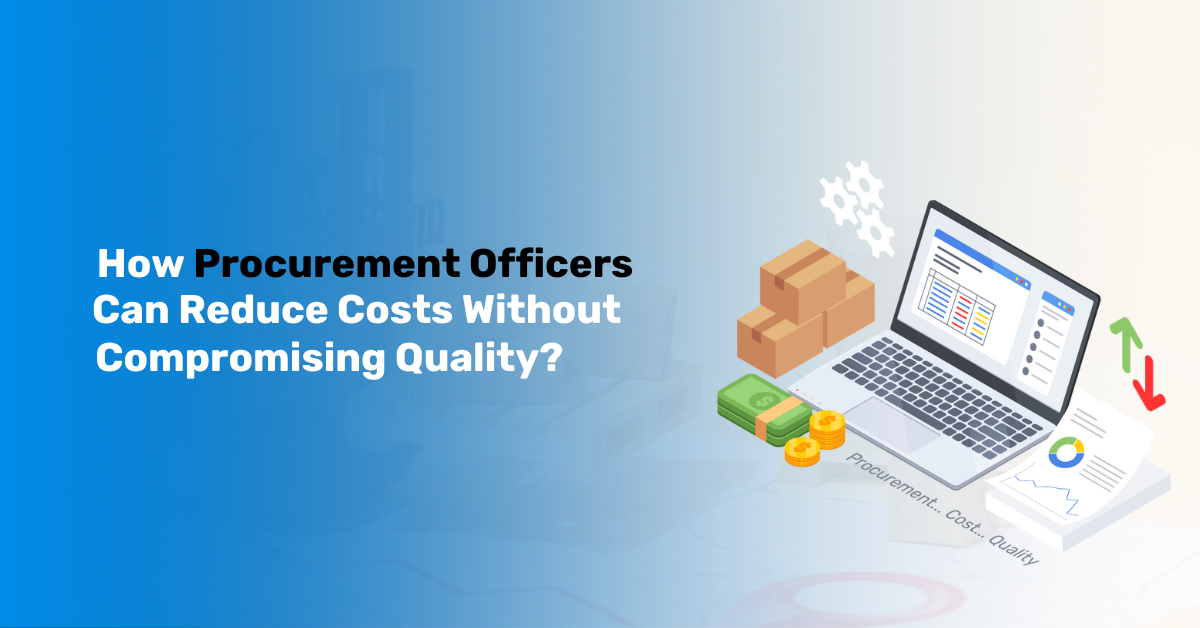Table of Contents
The best procurement strategy isn’t just about getting the lowest price, but about finding the best value for your organisation, and that often means prioritising quality alongside cost savings.
A 2023 study by McKinsey & Company titled “ A new era for procurement: Value creation across the supply chain” emphasises the ongoing pressure on procurement professionals to achieve cost savings. However, the report also highlights the critical importance of quality in today’s competitive landscape. This seemingly simple task can be complex, requiring careful planning, strategic negotiation, and a deep understanding of the market.
On one hand, pressure to reduce costs is ever-present. Hospitals strive for procurement cost savings in medical supplies, manufacturers seek lower production costs, and businesses across industries are constantly looking for ways to reduce costs in procurement.
However, simply focusing on the bottom line can have negative consequences. Cutting corners on quality can lead to hidden costs in the long run, such as:
- Warranty claims: Lower-quality products may break down more frequently, which could lead to warranty claims and other associated costs.
- Increased maintenance: Subpar materials or construction may require more frequent maintenance, creating a hole in the budget.
- Damage to Reputation: Products that fail to meet quality standards can damage your company’s reputation, impacting future sales.
Ultimately, the goal is to achieve value, which is the balance between cost and quality. This requires a strategic approach that goes beyond simply finding the lowest price tag.
What Strategies Can Be Implemented To Reduce Costs In Procurement without Compromising Quality?
Fortunately, there are strategies procurement officers can maximise to achieve cost savings in procurement without sacrificing quality:
1. Scrutinize Proposals with a Cost-Quality Lens:
Don’t be fooled by a low initial price tag. Carefully scrutinise proposals with a focus on both cost and quality.
- Analyse Quality Specifications:
Look beyond the headline price and focus on the details. Assess the materials used, technical specifications, warranty terms, and after-sales support offered by each vendor.
- Life Cycle Costing:
As mentioned earlier, do not just consider the initial purchase price. Factor in the long-term costs associated with quality, such as potential warranty claims and maintenance needs. This helps to identify hidden costs that could erode any cost savings achieved through a lower initial price.
2. Market Trends for Informed Decisions:
Stay informed about market trends to make strategic procurement decisions and reduce costs in procurement.
Market Analysis: Conduct thorough market research to understand current and projected pricing trends for the required product or service. This knowledge can help you negotiate better deals and avoid price fluctuations that could impact your budget.
3. Total Cost of Ownership (TCO) Analysis – Beyond the Initial Price Tag
Understanding the Total Cost of Ownership (TCO) helps for effective cost analysis and cost savings in procurement.
Calculate TCO: Calculate the TCO for each option by considering factors like training needs, installation & set-up, maintenance & repairs fees, disposal costs, and potential warranty claims. A lower initial price tag might be offset by higher ongoing costs.

4. Supplier Evaluation: Quality and Reliability Matter
Don’t settle for just the cheapest option! Evaluating potential suppliers goes beyond price to ensure consistent quality and reliable service. Here’s a two-pronged approach to reduce costs in procurement:
A. Evaluate Supplier Capabilities and Track Records:
- Quality Control Process: Assess a supplier’s ability to consistently meet your quality standards. Do they have robust quality control processes in place? How do they ensure their products or services meet specifications?
- Track Record of Excellence: Investigate the supplier’s history. Look for a proven track record of delivering high-quality goods or services on time and within budget. Consider customer reviews and industry references to gauge their reliability.
- After-Sales Support: A strong after-sales support system is important. verify the supplier’s responsiveness to inquiries and their ability to provide timely assistance if issues arise.
B. Supplier Commitment to Quality (It’s Not Just About Can They, But Will They?)
Here’s what to consider for procurement cost savings:
- Quality Management Systems: Do they have a formal quality management system in place, like ISO 9001? This demonstrates a structured approach to maintaining high standards.
- Certifications: Certifications from independent bodies can assure you of their commitment to quality. Look for industry-specific certifications relevant to the product or service.
- Continuous Improvement: A culture of continuous improvement is a strong indicator. Do they actively seek ways to enhance their processes and product quality?
By thoroughly evaluating both a supplier’s capabilities and their dedication to quality, you can identify reliable partners who can deliver consistent value for your organization and also reduce costs in procurement.
5. Negotiate for a win-win Partnerships with Suppliers
Here are key ways to achieve this balance, reduce costs in procurement and not compromise on quality.
A. Understanding Common Law Practices
A strong understanding of contract law principles helps procurement officers negotiate clear and enforceable contracts that safeguard the organisation’s interests. This includes:
- Quality Standard Specifications: Clearly define acceptable quality standards within the contract. This provides a benchmark for measuring performance and holding the supplier accountable.
- Warranty and Service Level Agreements (SLAs): Negotiate clear terms for warranties and service level agreements (SLAs). These ensure prompt repairs, replacements, or other forms of recourse if quality falls below expectations.
- Termination Clauses: Include clear termination clauses for situations where quality issues persist. This protects the organisation from being locked into a subpar agreement.
B. Performance-Based Incentives
Performance-based incentives create a win-win scenario for both parties. These incentives reward suppliers for exceeding quality expectations or achieving specific performance benchmarks. Here’s how it works:
- Bonus Structures for Excellence: Implement bonus structures that reward suppliers for consistently exceeding quality expectations. This fosters a culture of continuous improvement and reinforces the importance of quality within the organisation.
6. Optimize Sourcing for Long-Term Value
Procurement officers face the challenge of adapting sourcing strategies to a dynamic market while reducing procurement costs, ensuring quality and mitigating risks. Here’s how to strike that balance:
Supplier Base Diversification (Don’t Put All Your Eggs in One Basket)
Relying on a single supplier can leave you vulnerable to disruptions, including:
- Quality Issues: If your sole supplier encounters quality control problems, your entire supply chain could be impacted.
- Price Fluctuations: A single supplier might have more leverage to negotiate higher prices.
- Supply Chain Disruptions: Events like natural disasters or political instability could disrupt your supply chain if you rely on a single source.
Benefits of Diversification:
- Reduced Risk: A diversified supplier base mitigates the impact of disruptions from any single vendor.
- Negotiation Power: Multiple suppliers create a more competitive environment, potentially leading to better pricing and terms.
- Exposure to Innovation: Engaging with diverse suppliers can expose you to new ideas and innovative solutions.
Diversification Strategies:
- Develop Relationships with Multiple Qualified Suppliers: Identify and vet several reliable suppliers that meet your quality and performance standards.
- Tiered Sourcing: Implement a tiered sourcing strategy, with primary and secondary suppliers for critical goods or services.
- Geographical Spread: Consider sourcing from geographically diverse locations to mitigate risks associated with regional disruptions.
7. Streamlining Vendor Management/ Supplier Management with Instanta
Reducing procurement costs goes beyond selecting the right vendors or suppliers; it also requires efficient management of those relationships. Here’s where a robust Vendor Management System (VMS) can significantly improve your procurement process and reduce costs in procurement.
Instanta, as a comprehensive enterprise asset management solution, offers a built-in vendor management system designed to streamline your vendor interactions and improve overall efficiency. Imagine a centralized platform that empowers you to:
- Simplify Communication and Collaboration: Assign tasks, send and receive requests for quotations (RFQs), and collaborate seamlessly with vendors on a single platform. This eliminates the need for email clutter and ensures clear communication throughout the procurement process.
- Enhanced Visibility and Control: Maintain a central repository of all vendor information, including contact details, past performance data, quotations, payment records, and performance ratings. This real-time access promotes informed decision-making and simplifies vendor performance monitoring.
- Effortless Purchase Order Management: Create and send purchase orders electronically, streamlining the procurement process and ensuring all parties are on the same page.
- Improved Payment Processing: Efficiently process payments to vendors directly through the platform, ensuring timely payments and fostering stronger supplier relationships.
By incorporating these functionalities within your procurement process, Instanta enables you to:
- Reduce Procurement Cycle Times: Streamlined communication, automated workflows, and centralized information significantly reduce procurement cycle times, allowing you to secure the goods and services you need faster.
- Minimize Errors and Improve Accuracy: A centralized platform minimizes the risk of errors associated with manual data entry and communication breakdowns.
- Strengthen Supplier Relationships: Improved communication, transparency, and timely payments foster stronger relationships with your vendors, leading to better service and potentially more favourable terms.
To learn more about how Instanta can streamline your vendor management and help reduce procurement costs, visit our website or contact us directly. Please email us at sales@sysservesolutions.com or call (+234) 201 291 4837, (+234) (0)703 978 4709.
Conclusion
When reducing costs in Procurement and achieving value, Balancing cost and quality is a constant pursuit. Procurement officers can navigate this challenge effectively by implementing the strategies outlined here.
Understanding the true cost of ownership (TCO) through TCO analysis helps informed decision-making. Negotiating win-win partnerships with suppliers through strategies like contract law knowledge and incorporating performance-based incentives into contracts ensures quality is prioritised alongside cost savings. Finally, adapting sourcing strategies with techniques like supplier-based diversification mitigates risks and fosters a more competitive environment.
Remember, successful procurement is not just about getting the lowest price, but about acquiring goods and services that deliver the optimal balance of cost, quality, and performance. This ensures long-term value for the organisation.



















